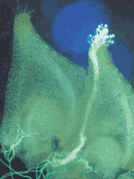Pollen Tubes Enter Neighbouring Ovules by Way of Receptacle Tissue, Resulting in Increased Fruit‐set in Sagittaria potamogetifolia Merr.

If at first you don't set seed, try, try, try again
In the remarkable double fertilization event that occurs in angiosperms, the pollen tube delivers two sperm nuclei to the embryo sac; one fuses with the egg cell to form the zygote and the other fuses with the diploid central cell to form the endosperm. It is not unusual for more than one pollen tube to reach an individual ovule but only one actually penetrates the ovule. In plants, as in many other sexual organisms, there are mechanisms to block polyspermy. Pollen tubes that are prevented from entering an ovule may continue to grow for a short time, but eventually atrophy and die. However, there are some exceptions to this. Xiao-Fan Wang and colleagues at Wuhan University in China (pp. 791-796) have carried out a detailed study of pollination and fertilization in Sagittaria potamogetifolia. This plant is pollinated by bees and can be both out- and in-breeding. It is very fertile, with individual plants achieving up to 100 % fruit set. The authors ascribe this at least partially to the behaviour of those pollen tubes that are prevented from entering the ovule in the block to polyspermy. Instead of curling up and dying, they continue to grow right through the base of the ovary into the receptacle and then grow upwards to seek ovules in adjacent carpels that have not been pollinated. These observations were verified experimentally by pollinating only one stigma with more than one grain. As predicted from the authors' descriptions of natural pollination, this led to fertilization of ovules in nearby carpels. These fascinating observations raise many more questions. Does the re-targeting of pollen give a clear selective advantage? Is this efficiency in pollen use associated with reduced pollen production? What are the mechanisms involved in the re-orientation of pollen tube growth? The authors clearly have several potentially fruitful avenues to explore.
Professor J. A. Bryant
University of Exeter, UK
j.a.bryant{at}exeter.ac.uk